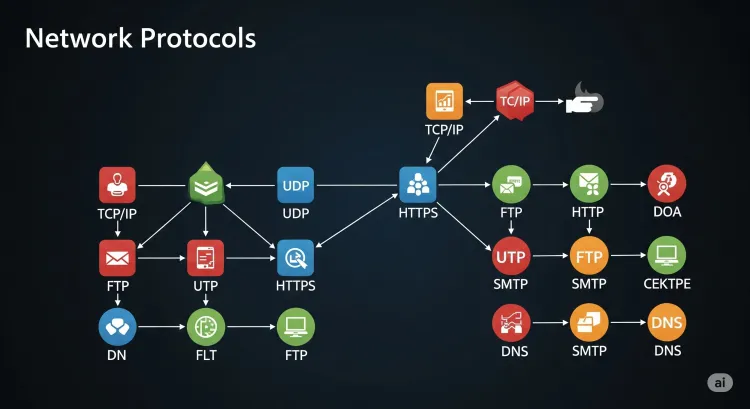What are the most common network protocols and how do they work?
Network protocols are standardized rules that define how data is transmitted and received across devices in a computer network. This blog explains key protocols like HTTP, TCP/IP, FTP, DNS, and more, with a detailed table covering their functions, ports, and usage. These protocols are essential for establishing reliable communication between systems, ensuring secure data transfer, and supporting internet and local network operations.

Table of Contents
- What Are Network Protocols?
- Why Are Network Protocols Important?
- Types of Network Protocols
- Common Network Protocols and Their Functions
- How Do Network Protocols Work Together?
- Protocols in Real-World Scenarios
- Conclusion
- Frequently Asked Questions (FAQs)
Network protocols are the rules and conventions that allow computers, servers, and devices to communicate over networks like the internet, LANs, or enterprise systems. These protocols define how data is transmitted, how errors are handled, and how devices identify each other. Without protocols, digital communication would be chaotic and unreliable.
In this blog, we explore what network protocols are, why they’re essential, the different types, and a comprehensive table listing major protocols used in modern networking.
What Are Network Protocols?

A network protocol is a standardized set of rules that dictate how data is transmitted between different devices on the same network. These rules cover aspects like:
-
Data formatting
-
Transmission speed
-
Error handling
-
Authentication
-
Compression
-
Session management
Protocols ensure interoperability between different devices and systems, regardless of hardware or vendor.
Why Are Network Protocols Important?
Network protocols are critical for:
-
Ensuring reliable communication across diverse devices
-
Enabling interoperability between hardware and software vendors
-
Securing data via encryption and authentication
-
Facilitating data routing and addressing
-
Supporting error detection and correction
For example, when you access a website, protocols like TCP/IP, HTTP, and DNS work behind the scenes to make that communication seamless.
Types of Network Protocols
Network protocols can be categorized into the following types:
-
Communication Protocols: Define how data is transmitted (e.g., TCP, UDP).
-
Routing Protocols: Handle path selection across networks (e.g., BGP, OSPF).
-
Security Protocols: Protect data integrity and confidentiality (e.g., SSL/TLS, IPSec).
-
Application Layer Protocols: Enable application-level communication (e.g., HTTP, FTP, DNS).
-
Session & Presentation Layer Protocols: Manage sessions and data formats (e.g., NetBIOS, RPC).
Common Network Protocols and Their Functions
| Protocol | Full Form | Layer | Function |
|---|---|---|---|
| IP | Internet Protocol | Network Layer | Addressing and routing data across networks |
| TCP | Transmission Control Protocol | Transport Layer | Reliable, connection-oriented communication |
| UDP | User Datagram Protocol | Transport Layer | Fast, connectionless communication |
| HTTP | HyperText Transfer Protocol | Application Layer | Web browsing and client-server communication |
| HTTPS | HTTP Secure | Application Layer | Secure web communication using SSL/TLS |
| FTP | File Transfer Protocol | Application Layer | Transfer of files between computers |
| SFTP | SSH File Transfer Protocol | Application Layer | Secure file transfer over SSH |
| SMTP | Simple Mail Transfer Protocol | Application Layer | Sending emails |
| IMAP | Internet Message Access Protocol | Application Layer | Email retrieval and mailbox management |
| POP3 | Post Office Protocol v3 | Application Layer | Downloading email from a server |
| DNS | Domain Name System | Application Layer | Resolving domain names to IP addresses |
| DHCP | Dynamic Host Configuration Protocol | Application Layer | Assigning IP addresses automatically |
| ARP | Address Resolution Protocol | Link Layer | Mapping IP addresses to MAC addresses |
| ICMP | Internet Control Message Protocol | Network Layer | Error reporting and diagnostics (e.g., ping) |
| SSL/TLS | Secure Sockets Layer / TLS | Security Layer | Encrypting data transmission over networks |
| SNMP | Simple Network Management Protocol | Application Layer | Managing and monitoring network devices |
| Telnet | - | Application Layer | Remote terminal access (not secure) |
| SSH | Secure Shell | Application Layer | Secure remote access and administration |
| BGP | Border Gateway Protocol | Network Layer | Routing between autonomous systems |
| OSPF | Open Shortest Path First | Network Layer | Internal network routing using shortest path algorithms |
| RIP | Routing Information Protocol | Network Layer | Distance-vector routing within small networks |
| IPSec | Internet Protocol Security | Security Layer | Secure IP communications using encryption and authentication |
| LDAP | Lightweight Directory Access Prot. | Application Layer | Accessing and maintaining distributed directory services |
| RDP | Remote Desktop Protocol | Application Layer | Remote desktop connections to Windows systems |
| NTP | Network Time Protocol | Application Layer | Synchronizing clocks between computer systems |
| NetBIOS | Network Basic Input/Output System | Session Layer | Allows applications on different computers to communicate |
| RPC | Remote Procedure Call | Session Layer | Enable function calls across networked systems |
| PPTP | Point-to-Point Tunneling Protocol | VPN Layer | VPN implementation for secure tunneling |
| L2TP | Layer 2 Tunneling Protocol | VPN Layer | VPN tunneling, usually paired with IPSec |
How Do Network Protocols Work Together?
Network protocols operate in layers (as per the OSI or TCP/IP model), where each layer is responsible for a specific function. For instance:
-
HTTP uses TCP for reliable delivery.
-
TCP uses IP to route data to the correct device.
-
IP uses Ethernet or Wi-Fi protocols for physical transmission.
This layered model allows modular development and easier troubleshooting.
Protocols in Real-World Scenarios
Scenario 1: Visiting a Website
-
DNS resolves the domain name.
-
HTTP/HTTPS initiates the connection.
-
TCP/IP ensures reliable transport.
-
SSL/TLS encrypts data.
Scenario 2: Sending an Email
-
SMTP sends the message.
-
IMAP/POP3 retrieves the message.
-
TCP/IP handles transport and delivery.
Conclusion
Network protocols are the foundation of the internet and modern communication. Understanding how they function and interact is essential for anyone working in IT, cybersecurity, or networking. As networks grow more complex, having a clear grasp of key protocols can enhance your ability to secure, maintain, and optimize systems effectively.
FAQs
What are network protocols in computer networking?
Network protocols are rules that govern how devices communicate over a network. They ensure proper data formatting, transmission, and receipt.
Why are network protocols important?
They enable reliable, secure, and standardized communication between computers and devices in any network.
What is TCP/IP?
TCP/IP (Transmission Control Protocol/Internet Protocol) is the foundational suite of communication protocols for the internet and most modern networks.
How does HTTP work?
HTTP (HyperText Transfer Protocol) is used for accessing web pages. It works on a request-response model between client and server.
What is the difference between TCP and UDP?
TCP ensures reliable, ordered delivery of data, while UDP offers faster transmission without guaranteed delivery.
What is FTP used for?
FTP (File Transfer Protocol) is used to transfer files between computers over a network.
How does DNS help in networking?
DNS (Domain Name System) translates domain names into IP addresses, allowing users to access websites using human-readable names.
What is DHCP?
DHCP (Dynamic Host Configuration Protocol) automatically assigns IP addresses to devices on a network.
What port does HTTPS use?
HTTPS typically uses port 443 for secure communication over the web.
What is the role of SNMP?
SNMP (Simple Network Management Protocol) is used to monitor and manage network devices.
Which layer does SMTP operate on?
SMTP (Simple Mail Transfer Protocol) operates at the Application layer of the OSI model.
Is SSL still used today?
SSL has been deprecated in favor of TLS, which is more secure and widely used today for encrypted communication.
What is ICMP used for?
ICMP (Internet Control Message Protocol) is used for diagnostic functions like pinging to test connectivity.
What is ARP in networking?
ARP (Address Resolution Protocol) maps IP addresses to MAC addresses within a local network.
Which protocols work at the application layer?
Protocols like HTTP, FTP, SMTP, and DNS operate at the application layer.
What is the function of the transport layer protocols?
They ensure reliable data transfer between host systems (e.g., TCP and UDP).
How does TLS enhance network security?
TLS (Transport Layer Security) encrypts communication between clients and servers to prevent data interception.
What is the OSI model?
The OSI model is a framework that standardizes networking functions into seven layers for better interoperability.
What are common TCP ports?
Common TCP ports include 80 (HTTP), 443 (HTTPS), 21 (FTP), 25 (SMTP), and 53 (DNS).
What are common UDP ports?
UDP ports include 53 (DNS), 67/68 (DHCP), and 161 (SNMP).
How does Telnet work?
Telnet is a protocol used for remote command-line login to devices over a network, typically unsecured.
What protocol does SSH use?
SSH (Secure Shell) provides encrypted remote access, using TCP port 22.
Can protocols overlap across layers?
Yes, some protocols span across layers for complex networking tasks.
What is the use of TFTP?
TFTP (Trivial File Transfer Protocol) is used for simple, unauthenticated file transfers.
What is NTP in networking?
NTP (Network Time Protocol) synchronizes the clocks of computers over a network.
What protocol does VoIP use?
VoIP often uses SIP (Session Initiation Protocol) and RTP (Real-time Transport Protocol) for voice transmission.
How do email protocols differ?
SMTP sends emails, while IMAP and POP3 are used to receive them.
What is the difference between HTTPS and SSL?
HTTPS is a secure version of HTTP that uses SSL/TLS for encryption.
What are the 7 layers of the OSI model?
Physical, Data Link, Network, Transport, Session, Presentation, and Application.
Which protocols are used for secure communication?
TLS, HTTPS, SSH, and SFTP are commonly used for secure data transmission.














![Top 10 Ethical Hackers in the World [2025]](https://www.webasha.com/blog/uploads/images/202408/image_100x75_66c2f983c207b.webp)








